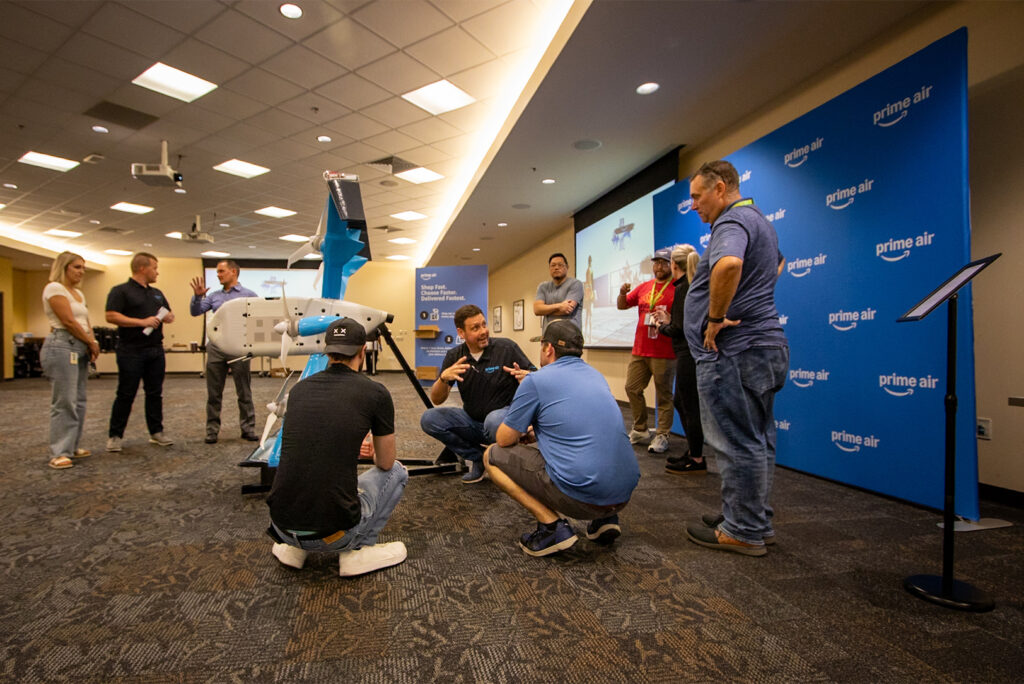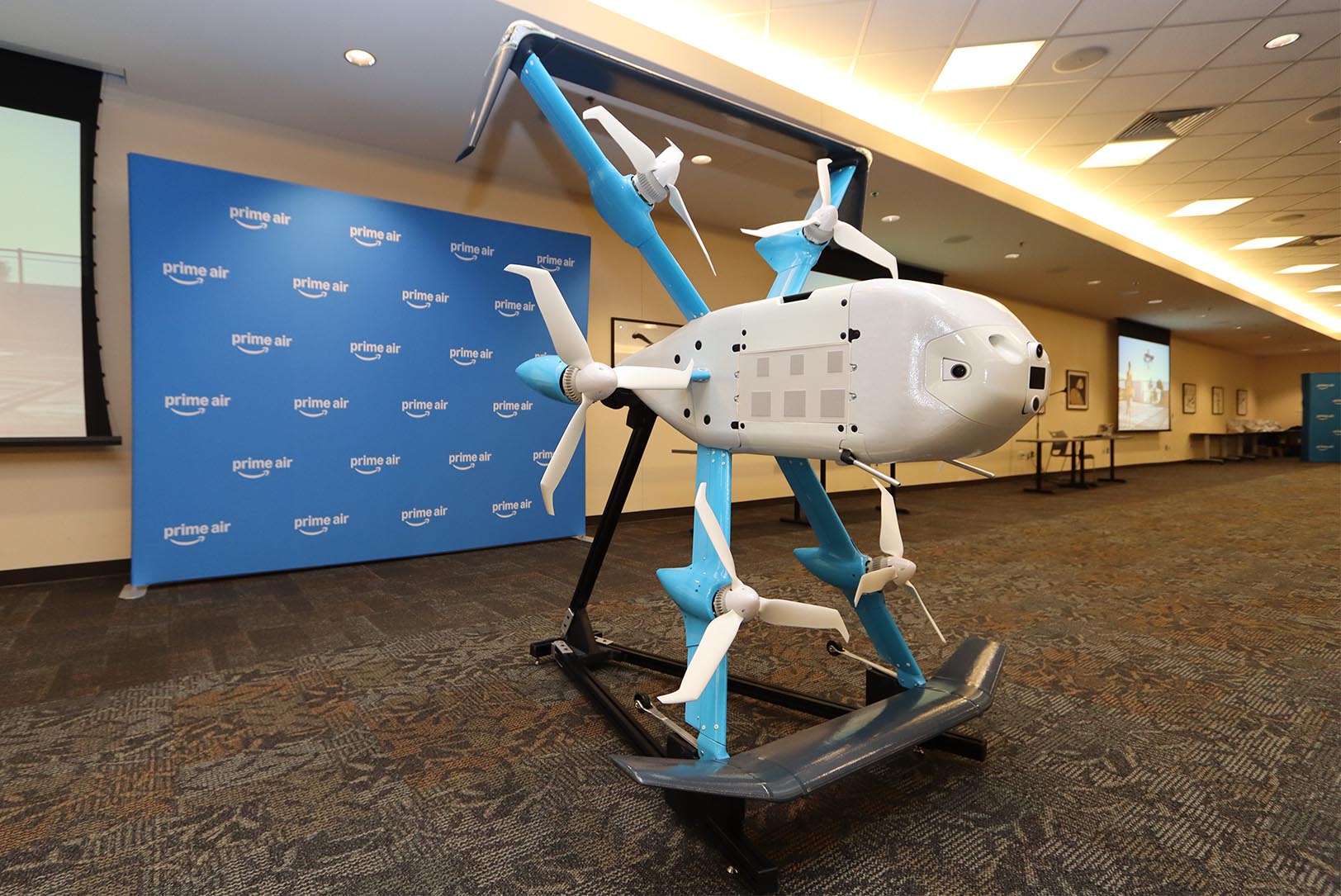As the nation prepares for large-scale commercial drone deployments — thanks in part to newly rolled-back federal regulations — pilots, businesses, and agencies using the tech must skillfully balance opportunity with public trust and privacy concerns, industry experts said.
“I’ve had people say to me, it kind of creeps me out … but in 30 minutes to get my thing; I’m definitely going to do it,” said Chris Preston, director of Prime Air operations for Amazon.
How Prime Air drones will work
- Amazon’s Prime Air drones fly autonomously on pre-planned routes, with no joystick or pilot in control.
- Each delivery mission is programmed from the fulfillment center, and the drone navigates using detect-and-avoid technology to steer clear of obstacles.
- A human “flight monitor” oversees the operation but can only issue two commands: trigger a return-to-home or a safe emergency landing if conditions change.
- Packages are lowered from about 12 feet above the ground, after which the drone climbs back and returns to its launch site for recharging.
Kansas City is expected to host two of Prime Air’s next fulfillment sites, each with a fleet of 12 drones. Activating this fall, each drone is capable of delivering packages under five pounds within 60 minutes of ordering inside a radius of 7.5 miles.
While the online retail juggernaut received Federal Aviation Administration approval in 2020 and began delivering via drone technology in 2022, recent policy developments in the nation’s capital are clearing a logjam that for years grounded other potential uses by a variety of operators.
Earlier this month, the FAA published a draft rule under Part 108, covering Beyond Visual Line of Sight (BVLOS) flights. The rule would replace the labor-intensive waiver process that has held the industry back since 2016, instead allowing approved operators to fly autonomously over longer distances.
“Everybody’s been waiting for this Part 108 beyond visual line of sight,” said Ryan Smith, president of Titan Protection, an Overland Park-based security firm. “The ARC report came out in 2022 … and it’s taken this long to even get to the draft rule.”
“The biggest issue we’ve had has been on visual line of sight regulation,” he continued. “For us to be able to do this effectively or really kind of have an impact, we need to remove the pilot from the equation and do that remotely.”
Titan Protection blends traditional guards with drone technology through a “drone as a service” model. The company’s autonomous drones work from docking stations and can launch, patrol, land and recharge with little human intervention.
RELATED: Drones may play big role in security for World Cup in Kansas City
The FAA’s proposal would:
- Authorize BVLOS operations up to 400 feet
- Expand drone weight limits beyond the long-standing 55-pound cap
- Shift airworthiness certification to industry standards, rather than FAA paperwork
- Require Remote ID, lighting and traffic-management data services
- Codify that drones must yield to crewed aircraft
The changes follow a June executive order from President Trump directing regulators to accelerate drone adoption, while also favoring U.S.-made drones over Chinese imports.

Drone aviation experts from Amazon Prime Air detail plans for service expansion into Kansas City at a press event in August; photo by Haines Eason
KC law enforcement buys in
While regulators debate timelines in Washington, Kansas City’s public-safety agencies are already preparing to put drones into the sky.
The KCMO Police Department is launching a “Drones as First Responders” program in September, after approving more than $600,000 in funding this spring.
Nine autonomous drones are expected to be deployed citywide, capable of flying in rain and winds up to 30 miles per hour, streaming infrared video back to dispatch.
The Lenexa Police Department began piloting drone response in March, showing a two-minute improvement on emergency call times. The city council recently approved nearly $1 million over five years to expand the fleet.
The Olathe Police Department followed suit this summer and soon will add drones to its toolkit for rapid emergency response. Prairie village is also incorporating the technology.
Across all coverage, supporters tend to focus on the benefits of getting “eyes in the sky” faster than officers can drive, and skeptics raise privacy concerns about cameras over neighborhoods and question whether drones truly free up officers or just add complexity.

An Amazon Prime Air delivery drone sits on display at a press event in August; photo by Haines Eason
Titan’s Smith acknowledges those tensions.
“A big concern is always privacy. Residents want to know how we’re storing images, how we’re training operators. We get questions like ‘What prevents the operator from zooming into the apartment complex window?’”
To that end, Titan Protection builds privacy safeguards into its drone program by geofencing drones to stay within a client’s property and adopting software that automatically blurs imagery outside those boundaries, Smith said.
And safeguards are left less and less to the whims of any given company, he added, noting insurers and regulators now ask more about how images are stored and operators are trained than about crash risks.
Given the tenuous and slow nature of the regulatory process, Smith said, strong safeguards are essential to maintain public trust and avoid setbacks for the entire drone industry.

Chris Preston, director of Prime Air operations for Amazon, speaks with reporters during a Kansas City press event in August; photo by Haines Eason
Amazon’s lift off
Perhaps no company symbolizes the hype — or the skepticism — around drones like Amazon.
The retail giant has been working on its Prime Air program for 13 years, spending billions on research and development, lobbying and test flights. So, while Amazon’s known as a move-fast kind of company, its drone program has been more marathon than sprint.
Development began in the early 2010s with repeated prototype unveilings and promises of near-term delivery that have taken time to materialize.
The company only launched full fulfillment sites in College Station, Texas, in 2022 and Tolleson, Arizona, in 2023. Plans for Kansas City’s two new sites were announced earlier this month.
Still, the company — and all operations deploying drones — face continued regulatory uncertainty. The Part 108 rule is only a proposal with a 60-day comment period and potentially years of revisions ahead. Even Amazon’s resources can’t accelerate Washington’s pace.

An Amazon Prime Air delivery drone is shown in operation on promotional signage at a Kansas City press event in August; photo by Haines Eason
Small businesses navigate the maze
Kansas City entrepreneurs are also finding niches — and headaches — in the drone boom.
Steve Winner, owner of Drone Services of Kansas City, leans on his 40-year aviation career and FAA experience to secure authorizations competitors can’t, he said.
A U.S. Air Force Academy graduate, he previously flew B-52s, Blackhawk helicopters and served as a military flight instructor before working for the FAA on instrument approach design and flight checks.
That background means he knows airspace rules, FAA processes and safety margins inside out — expertise he now applies to navigating authorizations and complex drone operations for clients, he said.
Winner sees growing comfort within the Kansas City community, he said.
“I get more waves and smiles when I’m in public and it’s not somebody thinking, ‘Oh my God, I’m being spied on,’” Winner mused.
But, he cautions that the industry is still misunderstood.
“Really the only people who control whether or not you can fly is the FAA,” Winner said. “Now, we always want to be a good neighbor and not be hovering over or outside somebody’s window while they’re having dinner.”
And, image isn’t the only challenge. For small operators, drone costs remain a barrier.
Winner notes that U.S.-made drones can cost several orders of magnitude more than comparable Chinese models, fueling debates over whether federal policy should prioritize domestic manufacturing.
Regardless of use, model, manufacturer or industry — delivering packages, patrolling parking lots and responding to 911 calls — momentum is accelerating for drone adoption, said Smith.
“It’s been slow, slow, slow, and then now it’s like a rocket ship up,” the Titan executive said.
10 years of drone regulation in the US
2016 – Part 107
FAA issues Part 107, the first comprehensive rules for commercial drones. Operators must pass a certification test; flights limited to 55 pounds, daytime only, within visual line of sight.
2017 – The Integration Pilot Program (IPP) launches
The UAS (Unmanned Aircraft Systems) IPP was launched in October 2017. This three-year program aimed to accelerate the safe integration of drones into the National Airspace System by partnering with state, local and tribal governments, along with private sector entities. The program concluded in October 2020.
2021 – Remote ID
New rule requires most drones to broadcast digital identification and location data, addressing security and accountability concerns.
2022 – ARC Report on BVLOS
FAA’s Aviation Rulemaking Committee publishes recommendations on how to scale BVLOS, laying groundwork for broader rulemaking.
2023-2024 – Waivers and Early Approvals
Companies like Titan Protection secure nationwide waivers for BVLOS in specific industries, but costs and delays limit adoption.
2025 – Part 108 Proposed
FAA releases draft rule normalizing BVLOS: performance-based standards, expanded weight limits, Remote ID required, industry-based certification. Paired with White House executive orders emphasizing speed and domestic manufacturing.
Haines Eason is the owner of startup content marketing agency Freelance Kansas. Previously he worked as a managing editor for a corporate content marketing team and as a communications professional at KU. His work has appeared in publications like The Guardian, Eater and KANSAS! Magazine among others. Learn about him and Freelance Kansas on LinkedIn.







































